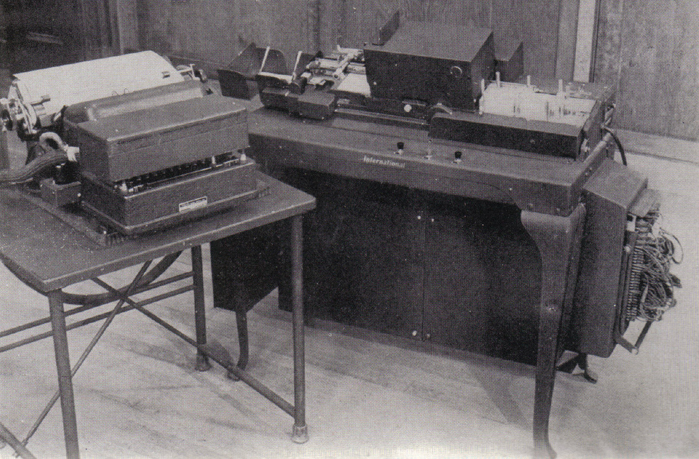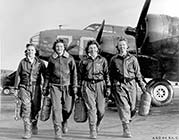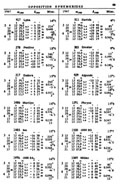The Naval Observatory
Table Printer 1945
The first programmed typesetting

|
| The IBM Electromatic Table Printing Machine, US Naval Observatory. Photo: About 1946, from Reference 4 below (CLICK to enlarge). |
Columbia University Astronomy Professor Wallace Eckert spent the wartime years at the US Naval Observatory, where he was put in charge of the Nautical Almanac Office in order to "computerize" it for rapid and massive production of accurate almanacs for air and sea navigation by Allied forces and shipping. To this task, he brought his knowledge of celestial mechanics and his own pioneering punched-card method of scientific computation —a nearly unique combination¹. In his own words:
"For a great many years, the Naval Observatory has published a nautical almanac and for about five years an air almanac. The purpose of either of these publications is to just give this information —what is the longitude and the latitude of any celestial object at any time. One of the reasons they vary is that in the past the nautical almanac was designed for the earth and the air almanac was designed for the air. They have plenty of time to use the nautical map while for aircraft navigation, a minute will take you a long ways... There are two pages per day of this information, thus 730 some pages [1.5 million figures] a year... They must be printedand there can be no error. If one of these figures is wrong, the navigator ... may lose himself and his plane." [84] (or herself!) →

WASPs in WWII
Eckert decided that in order to achieve both beauty (clarity, compactness, and elegance) and perfect accuracy (by eliminating the copying, hand typesetting, proofreading, and correction steps), a form of "computer"-driven typesetting is required, in which tables of numbers calculated by computing machines are input directly to a composing typewriter capable of creating publication-quality masters. As a stopgap at the beginning of the War, existing punch-card printing devices (principally the IBM 405 Accounting Machine) were modified to produce accurate and readable Air Almanacs for 1942-45 by an intricate two-pass printing procedure, using special typebars and ribbons. Meanwhile, a card-driven composing typewriter specified by Eckert in 1941 (before the US entered the War) and built by IBM, was capable of proportional spacing, boldface, superscripts and subscripts, letters, numbers, punctuation, and special symbols, with layout and other details programmed by a combination of master card and plugboard; it was delivered in 1945 and produced its first Air Almanac in 1946 [77]. It was called the Electromatic Table Printing Machine, consisting of a modified IBM Electromatic Proportional Spacing Typewriter² connected to a modified Type 016 IBM keypunch³. According to Hollander (reference below), only two were made: one for Eckert and one for IBM Headquarters. According to Herb Grosch (reference below), however, Eckert said in later years that additional units had been manufactured for other almanac-printing sites (Grosch later learned that a British copy was installed at HMNAO Herstmonceux Castle in February 1953, and estimates there might have been a half-dozen more).
As of January 2011, we have some excellent photos of the IBM 031 Card Punch, thanks to Paul Varnum of the Iowa Department of Transportation, which bears such an uncanny resemblence to the punch shown above that I'd be tempted to say the Table Printer used an 031 and not an 016.
Although composing typewriters had existed previously, they were operated by
keyboard, a source of error.
Linotype machines
were available that were driven by punched paper tape, but the tape punch
was operated by keyboard too, so the probability of error was not reduced.
Mathematical tables had previously been published as photographic
reproductions of printouts from standard unmodified computing-machine
printers, but these were bulky and unclear. Feeding numbers calculated by
computing machines and punched onto cards directly to a high-quality
printing apparatus solved all of these problems. The machines used to print
the Air Almanac for 1942-46 —Eckert's modified 405 and then the
Table Printer —were almost certainly the first computer-driven
typesetters
_____________________
- L.J. Comrie was his counterpart in
England.
- Earlier Electromatic models were also used on
COLOSSUS
and ASCC.
- Herb Grosch explains, "The master card would go in the [016's]
'to-and-fro' rack [precursor to the program drum of the
026], with a
skip bar clipped to the front of the
carriage; a notch said skip, a deeper notch said copy. It might also have
been possible to put repetitious data on the master card."
- The word "computer" is used in the general sense of computing machine. The word "typesetter" is used in the sense of a device capable of producing publication-quality camera-ready offset masters.
The Table Printer Character Set

Pictured is the complete Table Printer character repertoire. As you can see, it includes only what is necessary to print each almanac page; alphabetic headings and labels were either preprinted on the paper or else stripped in afterwards (typewriters with switchable type balls would not appear until the 1960s). Thus, the Table Printer was not a general purpose typesetter, but it was a typesetter. In Eckert's words: "There are 88 characters which, after photographic reduction, give 8-point light figures, 8-point bold figures, 8- and 6-point figures on the half line (without moving the platen), 6-point figures on the line, various kinds of decimals, plus and minus signs, etc., Roman numerals, and special symbols for the Air Almanac" (Reference 4 below). The escapement permits horizontal spacing in units of 1/32 inch and vertical spacing of 1/12 inch.

| The sample chosen by Hollander (reference below) to illustrate the extreme flexibility of the table printer, from the reprinting by Paul Herget of the emergency 1947 Kleine Planeten produced at Columbia's WSCL at the end of 1946 (Grosch, page 81). From the Hollander article: "The Minor Planet Ephemerides … are a masterpiece of typing. They illustrate most of the capabilities of the typewriter on one page. The only printing not done by the card-operated machine was the planet names. They were typed in by hand on an IBM proportional spacing typewriter." CLICK ON IMAGE to enlarge and see 8- and 6-point type, printing on the half line, various symbols, etc. For additional samples, see the World War II Air and Nautical Almanacs. |
- United States Navy Nautical Almanac Office, The American Air Almanac, US Government Printing Office, Washington DC (issues from 1940 to 1946).
- Eckert, W.J., "The Construction of the Air Almanac", 68th Meeting of the American Astronomical Society, New Haven CT, 12-14 June 1942.
- Eckert, W.J., "Air Almanacs", Sky and Telescope, Vol.4, No.37 (Oct 1944).
- W.J.E. (Wallace J. Eckert) and Ralph F. Haupt, "The Printing of Mathematical Tables", Mathematical Tables and Other Aids to Computation, Vol.2, No.17 (Jan 1947), pp.197-202.
- Hollander, Frederick H., "Punched Card Calculating and Printing Methods in the Nautical Almanac Office", Proceedings, Scientific Computation Forum, IBM, New York (1948).
- Eckert, W.J., Punched Card Methods in Scientific Computation, The Thomas J. Watson Astronomical Computing Bureau, Columbia University, Lancaster Press, Inc., Lancaster PA (January 1940).
- Grosch, Herbert R.J., Computer: Bit Slices from a Life, Third Edition, 2003 (in manuscript), especially pages 62-65).
- World War II Air and Nautical Almanacs.
- Wallace Eckert
- Minor planets for 1947 (printed on Table Printer)
- US Naval Observatory - 1941 (photo)
- Wallace Eckert Exhibit (Smithsonian Institution).
- USNO history (many more like this have disappeared).
- Herb Grosch for reviewing this page (among many others!), adding his personal recollections, and supplying the almanac page scans.
Translations of this page courtesy of...
| Language | Link | Date | Translator | Organization |
|---|---|---|---|---|
| Belarusian | Беларуская | 2023/08/22 | Vladyslav Byshuk | Владислав Бишук | studycrumb.com |
| Finnish | Suomi | 2023/08/31 | Kerstin Schmidt | https://admission-writer.com/ |
| French | Français | 2023/08/31 | Kerstin Schmidt | prothesiswriter.com |
| German | Deutsch | 2023/08/31 | Kerstin Schmidt | writemypaper4me.org |
| Hungarian | Magyar | 2023/08/31 | Kerstin Schmidt | https://writemyessay4me.org/ |
| Italian | Italiano | 2023/08/31 | Kerstin Schmidt | pro-academic-writers.com |
| Polish | Polski | 2023/08/31 | Kerstin Schmidt | justdomyhomework.com |
| Russian | Русский | 2023/08/22 | Vladyslav Byshuk | Владислав Бишук | skyclinic.ua |
| Spanish | Español | 2023/05/08 | Chicks Gold Inc. | |
| Ukrainian | Українська | 2023/08/22 | Vladyslav Byshuk | Владислав Бишук | studybounty.com |